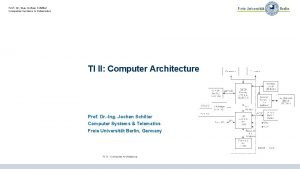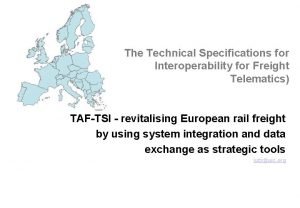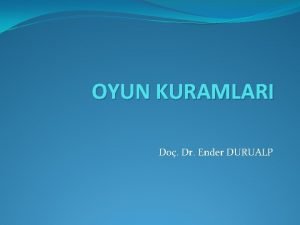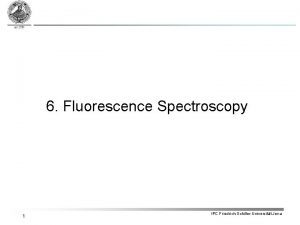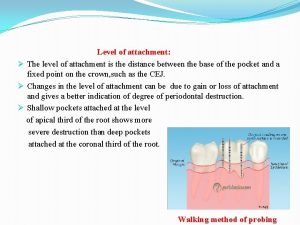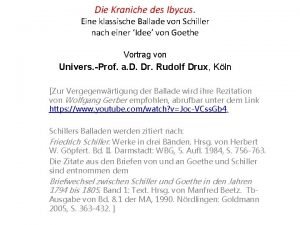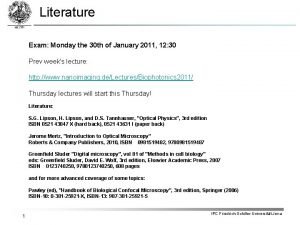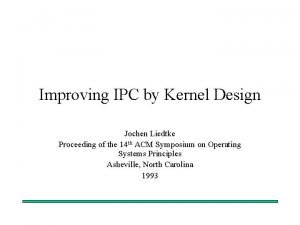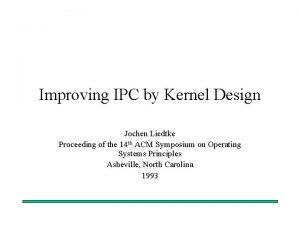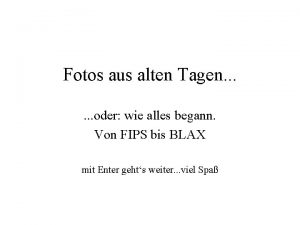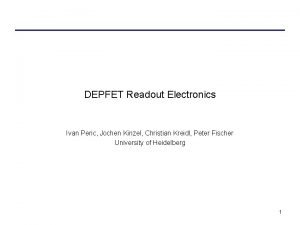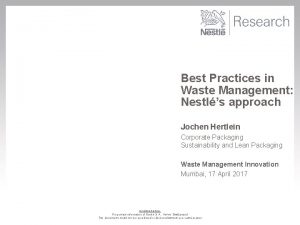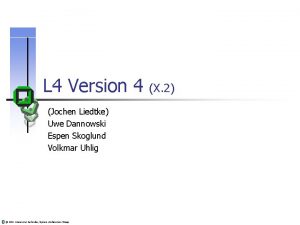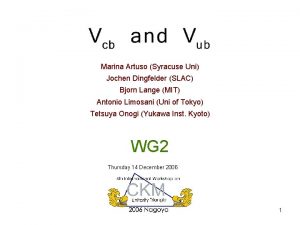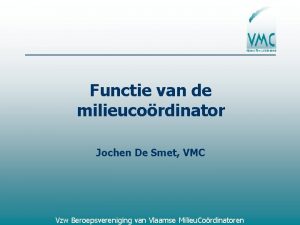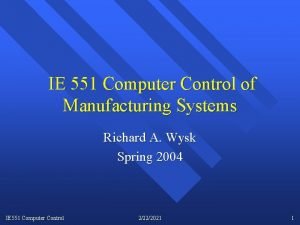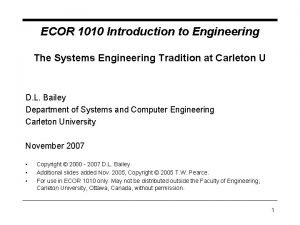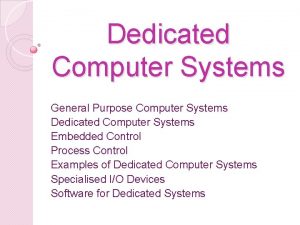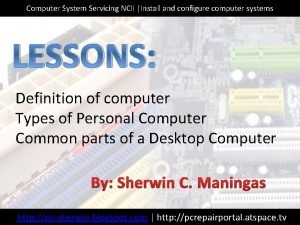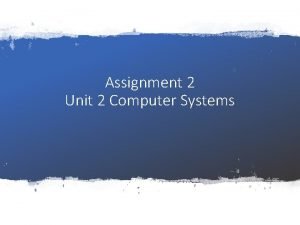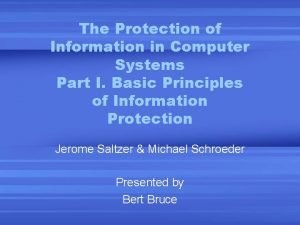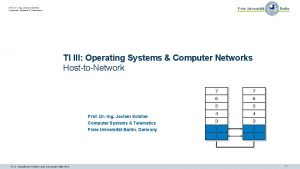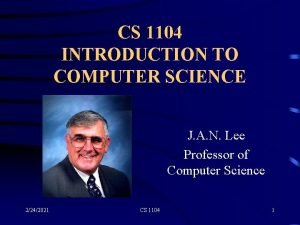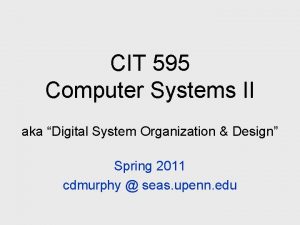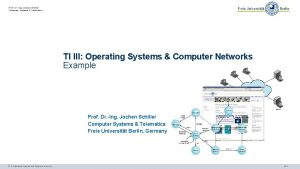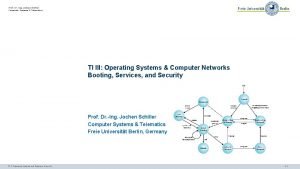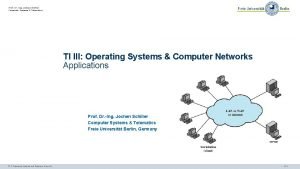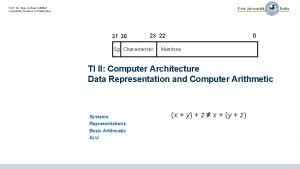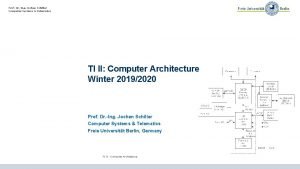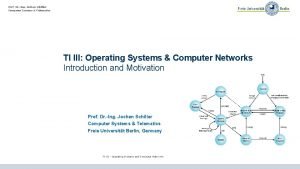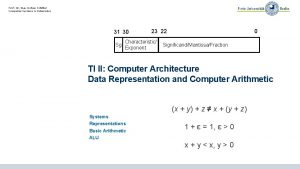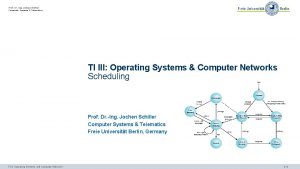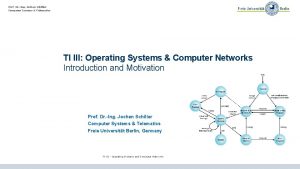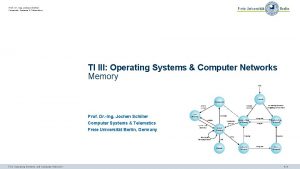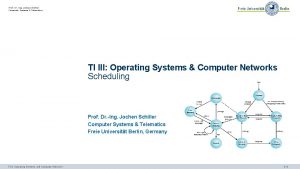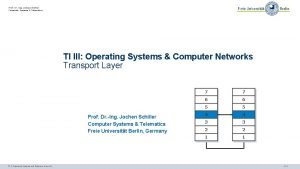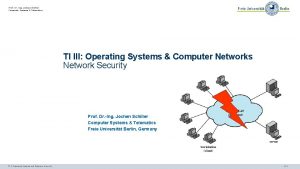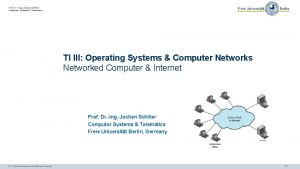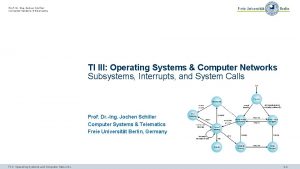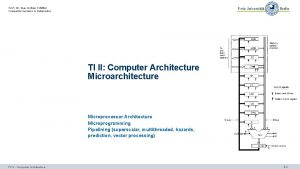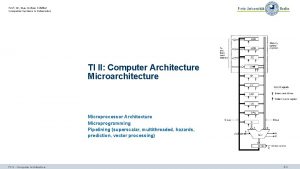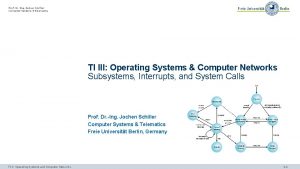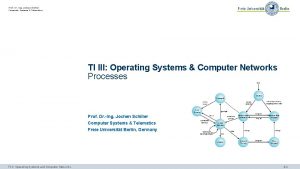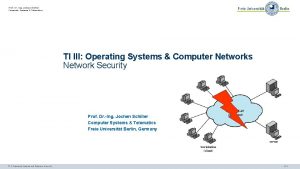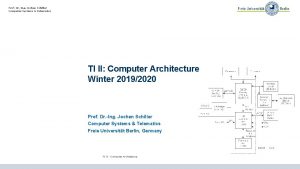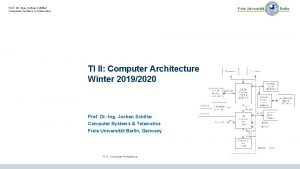Prof Dr Ing Jochen Schiller Computer Systems Telematics



















































- Slides: 51

Prof. Dr. -Ing. Jochen Schiller Computer Systems & Telematics TI III: Operating Systems & Computer Networks I/O and File System Prof. Dr. -Ing. Jochen Schiller Computer Systems & Telematics Freie Universität Berlin, Germany TI 3: Operating Systems and Computer Networks 6. 1

Content 1. Introduction and Motivation 2. Subsystems, Interrupts and System Calls 3. Processes 4. Memory 5. Scheduling 6. I/O and File System 7. Booting, Services, and Security TI 3: Operating Systems and Computer Networks 6. 2

Operating System Design and I/O TI 3: Operating Systems and Computer Networks 6. 3

Operating System Design and I/O Efficiency Problems - I/O (usually) cannot keep up with processor speed - Use of multiprogramming allows for some processes to be waiting on I/O while another process executes - Most I/O devices extremely slow compared to main memory - Swapping is used to bring in additional Ready processes (requires I/O operations) Generality - Desirable to handle all I/O devices in a uniform manner, i. e. , provide good abstraction to application programmer - Hide most of details of device I/O in lower-level routines ØProcesses and upper levels see devices in general terms, e. g. , read, write, open, close, lock, unlock ØConflicting goals motivate focus on API design TI 3: Operating Systems and Computer Networks 6. 4

Types of I/O Devices Wide variety of I/O devices - Human readable, e. g. , display, keyboard, mouse - Machine readable, e. g. , disk and tape drives, sensors, controllers, actuators - Communication, e. g. , digital line drivers, modems Data rate - Application (software support, priority) - Complexity of control - Unit of transfer (stream, blocks, characters) - Data representation - Encoding schemes - Error conditions TI 3: Operating Systems and Computer Networks 6. 5

Alternatives for I/O Organization Device abstraction - Character-based I/O - E. g. input devices like keyboard or mouse - Block-based I/O - E. g. data storage ØNot necessarily related to implementation, e. g. USB Communication endpoint (socket) abstraction - Used for networking ØSecond part of this lecture File abstraction - Structured, persistent storage - Sometimes with additional semantics, e. g. , locking, transaction support, etc. TI 3: Operating Systems and Computer Networks 6. 6

I/O Related Programming Techniques Programmed I/O - Process is busy-waiting for the operation to complete while (*IO_STATUS_ADDR != IO_DONE){} Interrupt-driven I/O - I/O command is issued - Processor continues executing instructions - I/O module sends an interrupt when done Direct Memory Access (DMA) - DMA module controls exchange of data between main memory and the I/O device - Processor interrupted only after entire block has been transferred TI 3: Operating Systems and Computer Networks 6. 8

Comparison of I/O Techniques Programmed I/O - Only when there’s no alternative, e. g. , timing with very high accuracy Interrupt-driven I/O - Event-based programming, e. g. , user input Direct memory access - Data transfer, e. g. disk I/O, graphics operations, network packet processing TI 3: Operating Systems and Computer Networks 6. 9

Direct Memory Access Moving data between main memory and peripherals is a simple operation, but keeps CPU busy ØDelegate I/O operation to extra hardware: DMA module transfers data directly to or from memory - “For-loop in hardware” ØContinuous memory regions When complete, DMA module sends interrupt signal to CPU TI 3: Operating Systems and Computer Networks 6. 10

DMA Configurations a) Single-bus, detached DMA ØSimple, but inefficient ØRequires multiple I/O requests to device b) Single-bus, integrated DMA-I/O ØEfficient, but expensive ØOne controller per device (group) c) I/O bus ØEfficient and less expensive ØSeparate bus, one controller TI 3: Operating Systems and Computer Networks 6. 11

I/O Buffering Main memory used to temporarily store data - Mitigates differences in data processing speeds - Processes must wait for I/O to complete before proceeding - Manage pages that must remain in main memory during I/O - Buffer must be accessible to low-level drivers and hardware Approaches (with different buffering strategies) - Block-oriented - Information is stored in fixed sized blocks - Transfers are made one block at a time - Used for disks and tapes - Stream-oriented (stream of characters) - Transfer information as a stream of bytes - Used for terminals, printers, communication ports, mouse and other pointing devices, and most other devices that are not secondary storage TI 3: Operating Systems and Computer Networks 6. 12

I/O Buffering Implementations No buffering TI 3: Operating Systems and Computer Networks 6. 13

I/O Buffering Implementations Single buffering - Block-oriented: User process can process one fixed-sized block of data while next block is read in - Stream-oriented: Process one variable-sized and delimited line at time TI 3: Operating Systems and Computer Networks 6. 14

I/O Buffering Implementations Double buffering ØProcess can transfer data to or from one buffer while OS empties or fills other buffer TI 3: Operating Systems and Computer Networks 6. 15

I/O Buffering Implementations Circular/ring buffering - Each individual buffer is one unit in circular buffer ØUsed when I/O operation must keep up with process TI 3: Operating Systems and Computer Networks 6. 16

Questions & Tasks - If you want to learn more, please check the hidden slides (i. e. slides not covered in the video/lecture but available via the PDF)! - Programmed I/O (PIO) looks pretty inefficient – but are there also situations where PIO has advantages over DMA? - Point out bottlenecks in the DMA configurations! Are you aware of more efficient solutions? (Hint: check current PC architectures, PCIe etc. ) TI III - Operating Systems and Computer Networks 6. 17

I/O Scheduling For a single resource there will be a number of I/O requests - From one or several processes - Some devices keep internal state, so ordering of I/O requests matters Example: Disk access - Access time - Sum of seek time and rotational delay - Time it takes to get in position to read or write ØSeek time is the reason for differences in performance - Data transfer occurs as the sector moves under the head ØReorder I/O requests according to current state of disk TI 3: Operating Systems and Computer Networks 6. 20

Disk Scheduling Algorithms TI 3: Operating Systems and Computer Networks 6. 22

Disk I/O Scheduling Policies Example - Disk with 200 tracks - Disk request queue has random requests - Order of requests 55, 58, 39, 18, 90, 160, 150, 38, 184 TI 3: Operating Systems and Computer Networks 6. 23

First-In, First-Out (FIFO) Processes in sequential order Fair to all processes Approximates random scheduling in performance if there are many processes competing for the disk Requests: 55, 58, 39, 18, 90, 160, 150, 38, 184 TI 3: Operating Systems and Computer Networks 6. 24

SCAN Also known as the elevator algorithm Arm moves in one direction only - satisfies all outstanding requests until it reaches the last track in that direction the direction is reversed Favors jobs whose requests are for tracks nearest to both innermost and outermost tracks Requests: 55, 58, 39, 18, 90, 160, 150, 38, 184 Service order: 150, 160, 184, 90, 58, 55, 39, 38, 18 TI 3: Operating Systems and Computer Networks 6. 26

Comparison of Disk Scheduling Algorithms TI 3: Operating Systems and Computer Networks 6. 30

Disk Cache Main memory buffer for disk sectors - Contains copy of subset of sectors on disk ØSpeeds up I/O requests to these sectors Policies: - Least Recently Used - Block longest in cache with no reference to it is replaced - Least Frequently Used - Block with fewest references is replaced ØReference count is misleading for bursty access patterns TI 3: Operating Systems and Computer Networks 6. 31

RAID Redundant Array of Independent Disks Set of physical disk drives viewed by the operating system as a single logical drive Data are distributed across the physical drives of an array Redundant disk capacity is used to store parity information TI 3: Operating Systems and Computer Networks 6. 32

RAID Level 5 Similar to RAID-4 but distributes the parity bits across all disks Typical allocation is a round-robin scheme Has the characteristic that the loss of any one disk does not result in data loss TI 3: Operating Systems and Computer Networks 6. 39

UNIX SVR 4 I/O Each individual device is associated with a special file: - /dev/dsp 0: First sound card - /dev/hda: IDE, primary master - /dev/hda 1: First partition on /dev/hda - /dev/tty: Controlling terminal -. . . I/O Two types of I/O: - Buffered (default) - Unbuffered (raw) TI 3: Operating Systems and Computer Networks 6. 41

Questions & Tasks - Compare an SSD with an HD when it comes to I/O scheduling. What are the differences? - What determines the performance of the different disk scheduling algorithms? - What are disadvantages of RAID-systems? Where do they have their single point of failure? TI III - Operating Systems and Computer Networks 6. 42

Content 1. Introduction and Motivation 2. Subsystems, Interrupts and System Calls 3. Processes 4. Memory 5. Scheduling 6. I/O and File System 7. Booting, Services, and Security TI 3: Operating Systems and Computer Networks 6. 43

File System Overview TI 3: Operating Systems and Computer Networks 6. 44

File System Overview Goals - Meet data management needs and requirements of user - Guarantee that data in file is valid (over time) - Optimize performance - Provide I/O support for variety of storage device types - Minimize or eliminate the potential for lost or destroyed data (redundancy) - Provide a standardized set of I/O interface routines - Provide I/O support for multiple users - Concurrency, access control, etc. TI 3: Operating Systems and Computer Networks 6. 45

File System Overview Types of File Systems Disk File Systems - Windows: FAT, FAT 16, FAT 32, NTFS - Linux: ext, ext 2, ext 3 - UNIX: UFS, … - MAC OS X: HFS, HFS+ Distributed File Systems - NFS, AFS, SMB Special Purpose File Systems TI 3: Operating Systems and Computer Networks 6. 46

File System Overview Properties - Long-term existence - Sharable between processes - Structure (internal /organizational) Typical File Operations - Create new file - Delete existing file - Open new/existing file - Close open file - Read data from open file - Write data to open file TI 3: Operating Systems and Computer Networks 6. 47

Elements of File Management TI 3: Operating Systems and Computer Networks 6. 50

File Directories Contains information about files - Attributes, e. g. , read/write/executable bits, access time - Ownership, e. g. , user/group or Access Control List (ACL) - Location with regard to logical structure of medium Directory itself may be implemented as file owned by operating system Provides mapping between file names and files themselves - “inodes” in Unix ØOne file can have multiple names (“hard links”) Structure - List of entries, one for each file - Sequential file with name of file serving as key - Initially no support for organizing files (except for naming) - Forces user to be careful not to use the same name for two different files TI 3: Operating Systems and Computer Networks 6. 59

Multi-Level Directories Hierarchical / Tree-Structure - Master directory with user directories underneath it - Each user directory may have subdirectories and files as entries - Some operating systems use multiple trees with own identifiers, e. g. , drive letters (A: , C: ) TI 3: Operating Systems and Computer Networks 6. 61

Hierarchical/Tree-Structured Directory Files are located by following path from root (master) directory down various branches ØPathname of file Supports several files with same file name as long as path names differ Per-process current directory is working directory Files are referenced relative to current working directory (CWD) TI 3: Operating Systems and Computer Networks 6. 62

Access Rights None Updating - User may not know of existence of file - User is not allowed to read user directory that includes file Knowledge - User can only determine that file exists and who its owner is Execution - User can load and execute program but cannot copy it Reading - User can read file for any purpose, including copying and execution Appending - User can add data to file but cannot modify or delete any of its contents - User can modify, delete and add to file’s data - Includes creating file, rewriting it and removing all or part of its data Changing protection - User can change access rights granted to other users Deletion - User can delete a file Owner - All rights previously listed - Grant rights to others using classes of users: - Specific user - User groups - Everybody • Complex access policies implemented with Access Control Lists (ACLs) Ø Watch out for semantic differences between files and directories! TI 3: Operating Systems and Computer Networks 6. 64

Questions & Tasks - Check out the file system on your computer – on the command line and using a window-based UI! How do you set certain access rights? Encryption? - Can a computer use different file systems at the same time for different storage devices? - We are typically very much used to tree-structures for file systems. Are there alternatives? What are advantages/disadvantages? - What is a link/shortcut? TI III - Operating Systems and Computer Networks 6. 69

Secondary Storage Management Secondary storage space must be allocated to files Must keep track of space available for allocation TI 3: Operating Systems and Computer Networks 6. 70

File Allocation On secondary storage, a file consists of a collection of blocks The operating system or file management system is responsible for allocating blocks to files The approach taken for file allocation may influence the approach taken for free space management Space is allocated to a file as one or more portions (contiguous set of allocated blocks) File allocation table (FAT) - data structure used to keep track of the portions assigned to a file TI 3: Operating Systems and Computer Networks 6. 71

Secondary Storage Management File Allocation Methods Contiguous allocation - Single set of blocks is allocated to a file at time of creation - Single entry in file allocation table (starting block, length of file) ØIncurs fragmentation; changing size of a file is expensive Chained allocation - Allocation on basis of individual block - Each block contains a pointer to next block in chain - Single entry in file allocation table (starting block, length of file) ØSeeking within file (random access) is expensive Indexed allocation - File allocation table contains a separate one-level index for each file - The index has one entry for each portion allocated to file - The file allocation table contains block number for index ØAvoids problems mentioned above, incurs some storage overhead TI 3: Operating Systems and Computer Networks 6. 73

Methods of File Allocation Contiguous File Allocation - A single contiguous set of blocks is allocated to a file at the time of file creation - Preallocation strategy using variable-size portions - Is the best from the point of view of the individual sequential file ØExternal fragmentation on disk TI 3: Operating Systems and Computer Networks 6. 74

Methods of File Allocation Chained Allocation - Allocation is on an individual block basis - Each block contains a pointer to the next block in the chain - The file allocation table needs just a single entry for each file - No external fragmentation to worry about - Best for sequential files ØLow random access performance TI 3: Operating Systems and Computer Networks 6. 76

Methods of File Allocation Indexed Allocation with Block Portions Index Allocation with Variable-Length Portions ØIndexing overhead ØGood compromise TI 3: Operating Systems and Computer Networks 6. 78

Questions & Tasks - Is secondary storage management only needed for hard disks? What about an SSD? - What are advantages and disadvantages of contiguous allocation? When/where can it be used? - What happens with indexed allocation when the index does not fit into a block? TI III - Operating Systems and Computer Networks 6. 85

Inodes All types of UNIX files are administered by the OS by means of inodes An inode (index node) is a control structure that contains the key information needed by the operating system for a particular file Several file names may be associated with a single inode - an active inode is associated with exactly one file - each file is controlled by exactly one inode TI 3: Operating Systems and Computer Networks 6. 87

Example: Linux VFS/Ext 2 The virtual file system is a layer between the kernel and the file system code Manages all the different file systems that are mounted The real file systems are either built into the kernel itself or are built as loadable modules TI 3: Operating Systems and Computer Networks 6. 97

Ext 2: Inodes Basic concept of the Ext 2 system (and of all Unix file systems) is the structure called inode (index node) A file is represented by one inode The length of files is variable but all inodes are of the same length (128 Byte) Smaller files are more quickly accessed than larger files TI 3: Operating Systems and Computer Networks 6. 98

Ext 2: Directories A directory is a file which is formatted with a special format - a list of directory entries ØAlso a directory has an inode Directory entries are of variable length ØFile names of varying length are supported An entry consists of - Inode number - Entry length - Name length - File name The first two entries for every directory are always the standard “. ” and “. . ” (“this directory” and “the parent directory”) The inode number of the root directory is stored in the super block so the system can access it directly at any time TI 3: Operating Systems and Computer Networks 6. 99

Related System Calls (Linux) int open(const char *pathname, int flags) - Open file at pathname with options flags and return file descriptor int close(int fd) - Close file desciptor fd ssize_t read(int fd, void *buf, size_t count) ssize_t write(int fd, const void *buf, size_t count) - Read/write data at buf with count bytes from/to file descriptor fd off_t lseek(int fd, off_t offset, int whence) - Seek, i. e. change current “cursor position”, in file descriptor fd by offset bytes in relation to whence (SEEK_SET, SEEK_CUR, SEEK_END) int fcntl(int fd, int cmd, long arg) int fcntl(int fd, int cmd, struct flock *lock) - Performs operation cmd on file descriptor fd, e. g. locking to protects against concurrent access, signaling on I/O, . . . ØIs this a well-designed interface? TI 3: Operating Systems and Computer Networks 6. 103

Content 1. Introduction and Motivation 2. Subsystems, Interrupts and System Calls 3. Processes 4. Memory 5. Scheduling 6. I/O and File System 7. Booting, Services, and Security TI 3: Operating Systems and Computer Networks 6. 104
 Jochen schiller
Jochen schiller Telematics api
Telematics api Telematics
Telematics Freight telematics
Freight telematics Ender durualp
Ender durualp Choregos vase
Choregos vase Die inhaltsangabe
Die inhaltsangabe Die bürgschaft zusammenfassung
Die bürgschaft zusammenfassung Schiller-duval
Schiller-duval Blackboard schiller
Blackboard schiller Schiller's potassium iodide test for attached gingiva
Schiller's potassium iodide test for attached gingiva Friedrich schiller gymnasium fellbach
Friedrich schiller gymnasium fellbach Die kraniche des ibykus youtube
Die kraniche des ibykus youtube Schiller duval bodies
Schiller duval bodies Bildungsroman entwicklungsroman unterschied
Bildungsroman entwicklungsroman unterschied Der handschuh schiller comic
Der handschuh schiller comic Bosnian serial killer
Bosnian serial killer Schiller blackboard
Schiller blackboard Jochen liedtke
Jochen liedtke Jochen liedtke
Jochen liedtke Delf jacobs
Delf jacobs Jochen kinzel
Jochen kinzel Nestls
Nestls Jochen mariss jeder schöne augenblick
Jochen mariss jeder schöne augenblick Jochen gerz monument contre le racisme
Jochen gerz monument contre le racisme Jochen liedtke
Jochen liedtke Jochen rehbein
Jochen rehbein Jochen dingfelder
Jochen dingfelder Jochen winkler
Jochen winkler Jochen wambach
Jochen wambach Verantwortungsübertragung
Verantwortungsübertragung Hans jochen schiewer
Hans jochen schiewer Jochen de smet
Jochen de smet Jochen kilgus
Jochen kilgus Decision support systems and intelligent systems
Decision support systems and intelligent systems Dicapine
Dicapine Embedded systems vs cyber physical systems
Embedded systems vs cyber physical systems Elegant systems
Elegant systems Computer control of manufacturing systems
Computer control of manufacturing systems Computer systems engineering carleton
Computer systems engineering carleton Examples of dedicated computers
Examples of dedicated computers Distributed systems vs computer networks
Distributed systems vs computer networks Key frame systems in computer graphics
Key frame systems in computer graphics Unit 2 computer systems
Unit 2 computer systems Installing and configure computer systems
Installing and configure computer systems Unit 2 computer systems assignment 1
Unit 2 computer systems assignment 1 The protection of information in computer systems
The protection of information in computer systems Computerized accounting conclusion
Computerized accounting conclusion Computer assisted guidance systems
Computer assisted guidance systems Computer systems
Computer systems Cs 1104
Cs 1104 Cit 595 upenn
Cit 595 upenn
